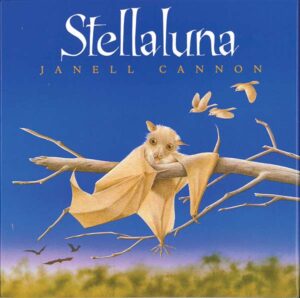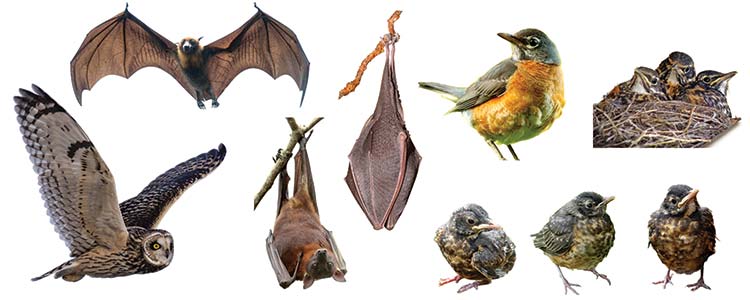Oral language, Print knowledge
Children will be familiar with the author Janell Cannon, including how her interest in animals helps her to write books for children.


Review:
 [Display book cover.]
[Display book cover.]
This week we will learn how another author and illustrator creates books. The name of the author and illustrator is Janell Cannon.
This is one of Ms. Cannon’s books. It is a book about a bat named Stellaluna.
[If you have read this book previously with children in your group, here is an alternative approach to the book. “We (some of you) have read this book before. What do we remember about this book?”]
When Ms. Cannon was a young girl, she liked all kinds of animals. She especially liked insects and other animals like bats, spiders, frogs, and snakes. She liked animals that most people didn’t like or were afraid of.
Sometimes, animals like frogs and snakes were her pets. She thought they were beautiful, even when other people didn’t think her animals were beautiful.
When Janell Cannon got to be a grown-up, she wanted to help children to learn about animals. She decided to draw pictures and write stories.
She gets ideas for her stories by watching real animals. Sometimes she looks at photographs of animals to help her draw.
Let’s read Stellaluna and see what happens. As we read the story, let’s think about what animals are in the book.
[Read the book without inviting talk until you have finished reading. Do not elaborate on book information unless children seem confused about what you are reading. Point to and describe illustrations directly related to text.]
What different animals are in this book? (bats, birds, owl)
Birds, owls, and bats are all real animals. Some of the things that they do in the book are real too. At the beginning of the story, Stellaluna hung upside down on a branch by her feet. This is something that is true. Bats hang upside down by their feet. It is a fact.
It is also a fact that owls chase other birds at night.
The idea that bats and birds talk to each other using people words is fiction. It is made up.
Ms. Cannon got ideas for her stories while she did drawings of animals. She uses her drawings, thinking, and imagination to create a story. Remember, we can think of new or pretend things when we use our imagination.
Some of the information in Ms. Cannon’s books is made up. Her stories also include true information about animals.
Today we learned about the author Janell Cannon. We learned that she likes animals. She gets ideas for her stories by watching animals and by drawing animals.
Extra support
Enrichment
Cut apart provided *bird, bat, and owl cutouts and place on the back of each a small hook and loop fastener for use on a flannel board. Encourage children to use flannel board pieces in retelling the story of Stellaluna.

*Printables provided
School-age children in your setting might enjoy helping you read Stellaluna to other children.
Number knowledge
Children will deepen their ability to form equal groups, groups with more items, and groups with fewer items.


Review:
Offer the Week 8, Day 2 activity to review forming equal groups.
Support children in making a group of items that is more than, fewer than, or equal to the number of dots on a randomly-selected card.
Explain that we will pick a dot card, and then each of us will practice making a group of counters (circles). The number of counters we put in our group may be more than, or fewer than, the number of dots on our card. The number of counters we put in our group also may be equal to the number of dots on the card. Remind children that equal means things have the same amount.
Place the dot cards face down in random order in a stack in front of you. Give each child 10 counters. Invite a child to pick one card and show it to all children. Then invite children to use their counters to make a group that is equal to the number of dots on the card. If appropriate, lead children in counting the number of dots on the card as you point to each dot.
Encourage children to return the counters in the group they made to their collection of 10 counters. Then invite another volunteer child to pick and display a different card. Encourage children to make a group that has more counters than the number of dots on the card. The number of counters children put in their respective groups does not matter as long as the group has more counters than the number of dots on the card.
Repeat the process described above, this time inviting children to make a group that has fewer counters than the number of dots on the selected card.
Continue as time and children’s interest permit. Alternate the three options (equal, more, fewer) unless it appears that children need more practice with one of the concepts.
Concentrate
Children will practice concentrating by looking at the color of a peer’s eyes.


Review:
[Arrange children sitting in a large circle, facing inward.]
We are learning how to concentrate on what we hear, see, and do. What does it mean to concentrate? (pay close attention to something)
We can understand something better when we concentrate on it.
Today we will concentrate on the person sitting next to us. We will play a game we’ve played before called the Hello Game.
We play the Hello Game by turning toward a person sitting next to us and saying “Hello.” Then we look in our neighbor’s eyes and tell our neighbor what color his/her eyes look like.
Let me show you.
[Sit next to an adult helper. Turn to the adult helper and say “Hello (adult helper). Your eyes look (color) to me today.” Then the adult helper turns to you to say “hello” and tells you what color your eyes look.]
(Adult helper) said my eyes look (color). Someone else might tell me my eyes look (different color).
The color of our eyes can look different at different times. That’s why we say “your eyes look a certain color,” and not, “your eyes are a certain color.”
Each of us will take a turn saying “hello” to our friend, and telling our friend what color his/her eyes look like. Let’s go around our circle in the order we are sitting.
[Begin with a volunteer child. Repeat the key words, or offer prompts, if necessary. See Extra Support tips. Continue until each child has had a turn.
If time permits, reverse the direction—turn to friend sitting on the left—so each child has an opportunity to say “Hello” and look into the eyes of a different peer.
If time permits:]
Now let’s quietly close our eyes and concentrate on our breathing for a few minutes.
Let’s put our hand on our stomach and pay attention to how our breath goes in and out of our body. Our stomach goes out when we breathe in, and in when we breathe out. We will take long deep breaths as we think about the air going in and out, in and out. Let’s let our body relax as we focus on our breathing. In and out . . . in and out. . . .
[Continue taking deep breaths together for a couple of minutes as children relax and concentrate on their breathing. Talk slowly and quietly as you encourage children to think of the air going in and out, in and out.]
Today we played a game we’ve played before that helped us look closely at the color of someone’s eyes. Was it hard to look into your neighbor’s eyes? Why? What did you learn about your neighbor’s eyes?
We also concentrated on our breathing. How did you feel when you concentrated on the air going in and out of your body? (relaxed, sleepy)
Extra support
Enrichment
In a quiet area of the room, provide several handheld mirrors for children to use. Encourage children to look at themselves in the mirror and describe what they see.
Invite children to greet family members at pickup time with an observation about the family member’s eyes. Example: “Hello Daddy, your eyes look brown to me today.”
Knowledge of earth and space
Children will recognize differences in external characteristics of rocks.


New:


Be Prepared: Today’s activity involves children going on a rock hunt outside. Bring a small cloth on the rock hunt to remove dirt that may be on rocks found by children. Also bring one plastic baggie per child. You may wish to write each child’s name on a baggie in advance of the rock hunt. If small rocks are not readily available in your classroom’s outdoor area, please import a variety of small rocks and place them in different locations in your outdoor space. Provide an average of 2–3 rocks per child. The activity may be adapted for indoor space, if necessary.
Today we will begin to learn about rocks. A rock is a hard object that makes up part of the earth. Rocks are all around us. Rocks can be found almost anywhere we go.
Today we will go on a rock hunt. We will each pick up the most interesting rock we see. Something that is interesting makes us want to look at it carefully or to know more about it.
Each of us will have our own idea about which rock is the most interesting.
Is it important for our friend to think we have found a very interesting rock? (no)
After each of us finds an interesting rock, we will bring our rocks inside and talk about what we found.
[Take children outside to look for rocks. Put each child’s most interesting rock in a separate baggie that is labeled with the child’s name.
After the rock hunt, invite children to sit in a large circle. Place the rocks in baggies in the center of the circle (not one rock in front of each child), with sufficient spacing between rocks so children can see the range of rocks collected during their hunt.]
We found some very interesting rocks today.
Today each of us looked for an interesting rock during our rock hunt. Our rocks are different in size, color, and shape. Tomorrow we will take a closer look at our rocks and learn what rocks are made of.
[Ensure children carefully wash their hands at the conclusion of the activity.]
Extra support
Enrichment
Add sand and several different types of rocks to the sensory table or tub. Provide magnifying glasses, cups, bowls, and spoons to support children’s experiences.
If possible, take children to an area with a large collection of rocks so they can look at a wide range of rocks.